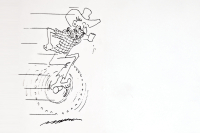Trio of quality books explore facets of faith
 Back in the day when the “culture wars” focused more on literature, music and movies — Tipper Gore, for example, then the wife of Al Gore, in 1985 led a crusade advocating age-appropriate labels on popular music — Christians often criticized the arts for their neglect of faith and their secular morality. Many churchgoers rejected mainstream culture altogether, turning instead to “Christian” books, films, and songs, nearly all of which were second-rate, didactic works lacking in real artistry.
Back in the day when the “culture wars” focused more on literature, music and movies — Tipper Gore, for example, then the wife of Al Gore, in 1985 led a crusade advocating age-appropriate labels on popular music — Christians often criticized the arts for their neglect of faith and their secular morality. Many churchgoers rejected mainstream culture altogether, turning instead to “Christian” books, films, and songs, nearly all of which were second-rate, didactic works lacking in real artistry.
These Christian critics, however, did have a point. Our increasingly secularized culture has become cruder, less given to nuance and offensive to many of “the religious right.”
Yet too often these same Christian critics have ignored or missed mainstream writers who do grapple with religious issues, who write sympathetically about religious faith. Susan Howatch, for instance, composed a series of novels on the Church of England in the twentieth century, books that wrestled with all manner of religious issues, and Marilyn Robinson’s Gilead has become a minor classic.
Mainstream writers, in fact, often deliver religious themes in their work, but hide these beliefs behind plot and character. Let’s look here at three new books, two from the bestseller lists, which reach large audiences but should resonate with Christians and with other readers.
First up on the list is Richard Paul Evans’s A Step of Faith (Simon and Schuster, 2013, 279 pages, $19.99). This is book number four in the “Walk” series, the story of Alan Christoffersen, an advertising executive who has lost his wife, his business and his home. Consequently, he sets out to walk from Seattle to Key West, hoping by this odyssey to leave his broken past behind him. A Step of Faith records Alan’s adventures on the road and the people he meets, including a religious fanatic, a wise and lovely hospice worker, and a young woman on the run. Alan himself also lands in a hospital, diagnosed with a brain tumor that proves to be benign.
A Step of Faith won’t appeal to all readers. As in his other books, Evans sometimes descends into bathos, yet he has found a wide readership, and this particular tale contains some bits of wisdom. Alan keeps a journal, and I particularly relished some quotes such as this one:
Related Items
“Sometimes it seems as if my life has been more intermission than show.”
Best-selling novelist Dean Koontz frequently includes spiritual struggles in his novels, and Innocence (Bantam Books, 2014, 338 pages, $28) is no exception. Here we meet Addison Goodheart, a young man driven to live beneath the streets of a great city because his face repels his fellow human beings. Raised by an alcoholic mother who could barely stand the sight of him, and then adopted by a man with a similar likeness, Addison survives by emerging from his shelter only at night, hiding his face and avoiding contact with people.
Until he meets Gwyneth. She is a young girl, an heiress, who is being pursued by a maniac who wants what remains of her fortune. Together she and Addison fight back against this man and his thugs. While we follow them in their flight through the city, Addison sees what he calls the Clears and the Fogs, which seem to be angels and demons.
To reveal more of the plot of Innocence would give away the ending. Suffice it to say that Koontz, like Evans, is not for everyone, but again he clearly appeals to tens of thousands of readers.
Finally, there is Anne Emery’s Blood on a Saint (ECW Press, 2013, 322 pages, $24.95). This novel, which I pulled with great good luck from the shelves of the public library, is the latest in Emery’s Collins-Burke mystery series. Father Brennan Burke is a hard-drinking, cigarette-smoking priest in Halifax, Nova Scotia, and Monty Collins is his best friend, an attorney with a love of the blues who is frequently involved in murder cases.
Emery, who lives in Halifax and is also an attorney, begins her tale when a young woman announces that she has seen a vision of the Virgin Mary in the courtyard of Father Burke’s church. Soon, as often happens, the courtyard becomes a circus of believers, reporters and conmen. Meanwhile, another woman, also claiming to see the Virgin Mary, is murdered, and a grungy television talk show host is arrested on suspicion of that killing. When Monty finds himself defending this man, whom he despises, Father Burke joins forces with him to help solve the case.
Emery has a particularly sharp eye for people and for ridiculous situations. One high point of this mystery — and there were many — occurrswhen the bishop requires Father Burke to appear on television with Pike Podgis, the show host, to explain the Church’s teachings on Marian apparitions. Anyone familiar with talk show hosts and the crude and rude way they sometimes treat their guests will find several laughs here.
Faith enters this novel through the hard-nosed Father Burke. At one point, during Burke’s homily at Mass, a baby begins crying. Burke goes on for a bit, but when the baby continues crying, he leaves the pulpit, approaches the mother, and takes the baby with him back to the pulpit. After a few remarks about the love of mother and child, Burke looks at the parishioners.
“There wasn’t a sound in the church except for his voice. Everyone looked at him, rapt with attention.
‘When anyone does anything to hurt another human being, when anyone takes another person’s life, this is who they are hurting, this is who they are killing. This is the life that is destroyed. Every one of us starts life as a helpless child like this. Any time we are tempted to mistreat a person, to lash out, to do a person harm verbally or physically or any other way, we must stop and think, that this is how we all began, this is who we all are. Everyone is precious in the eyes of God, and everyone should be precious to each and every one of us. If we can’t see the face of Christ in every person, and I admit it is difficult with some, then we should do our best at least to see the face of the child.’
“Monty took a quick look at his fellow choristers. To a man, to a boy, they had their eyes fixed on Father Burke. They were stunned into silence and immobility.”
Good scene. Good book.
(Jeff Minick is a writer and teacher. His first novel, Amanda Bell, is available regional bookstores and at Amazon.com.)









